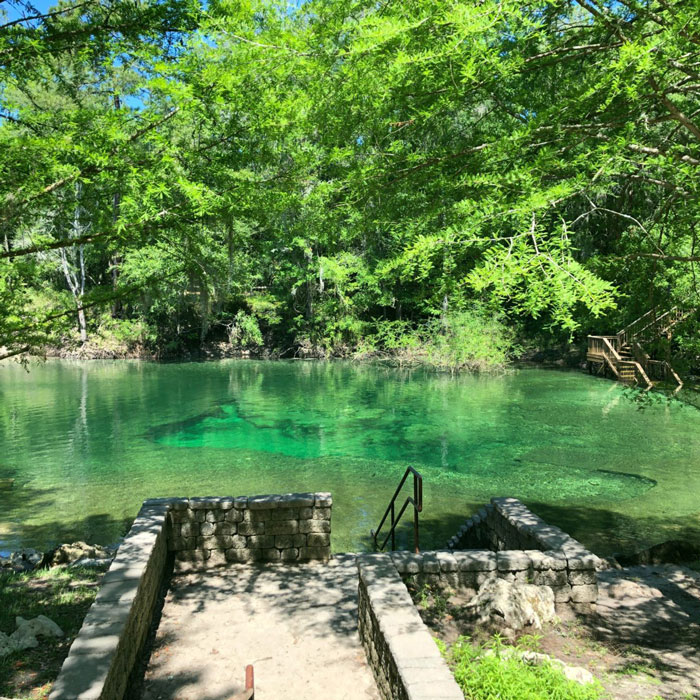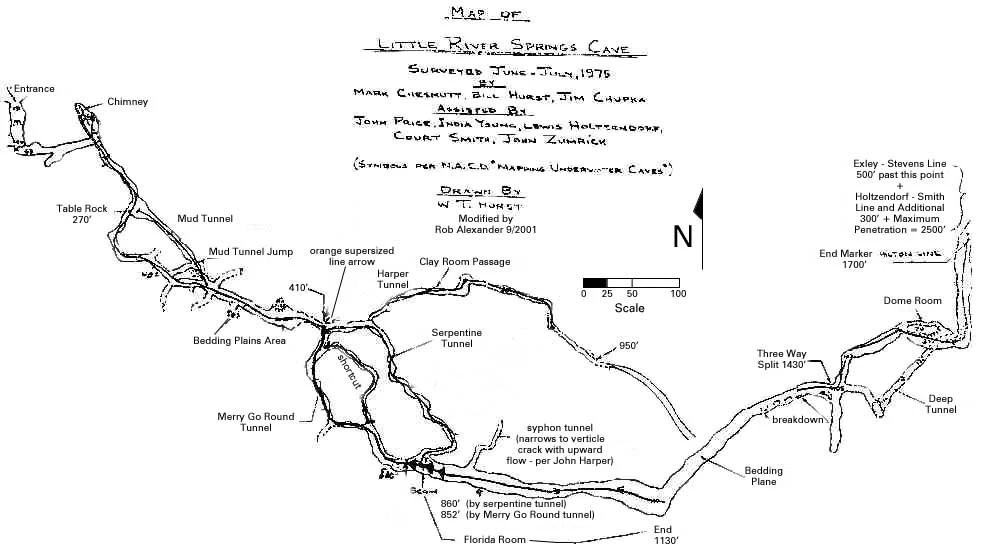Tragic Incident at Little River Springs in Florida: The Story of Jerry Duwayne Beets


| Incident Location | Diver Full Names |
|---|---|
| USA, Florida, Little River Springs | Jerry Duwayne Beets |
They both were well familiar with this cave system but during this dive they got into trouble and got themselves in a horrible situation. Are you enjoying our cave diving videos and not subscribed yet? Please consider subscribing to our channel! Little River Springs is located in the Spring Country region in the northern part of Florida.
Little River Springs
It occupies about 125 acres (50 ha) of land in the Suwannee River county park. The Little River Springs has clear water compared to the tea-colored Suwannee River. They also have temperature differences. Several recreational activities are available at the Little River Springs, including the popular snorkeling, swimming, canoeing, kayaking, and scuba diving that draw the attention of many divers.
Popularity of Little River as a Cave Diving Site
Little River is one of the most popular cave diving sites of North Florida. The cave is located between the well-known Devils Eye and Devils Ear and the Ichetucknee Jug Hole and other sites such as Peacock and Cow Spring. The spring is about 150 ft (46 m) in length and has over a 1,200 ft (366 m) long cave system in it.
Exploring the Cave System
The cave has just one main tunnel but some offshoots and bypasses when you get to a depth of 90–100 ft (27–30 m). Within the first 100 ft (30m), one of the most intriguing characteristics may be found as you descend an underwater corkscrew to reach the cave’s main chamber. As you go farther into the cave, you will discover that the system of the cave changes. It becomes lower and wider with thicker silt covering its walls and floors compared to the beginning of the cave, which has huge rocky passages that have diver traffic and clean water.
Reaching the “Well Casing”
If you can dive to the end of the cave, you will see the “Well Casing”. Here you will see a man-made well that a farmer had sunk into the spring to make use of the crystal clear water of the spring. On the 26th of November, 2003, a day preceding Thanksgiving, 42-year-old Jerry Duwayne Beets went for a dive at Little River Springs together with his uncle Kane Overfield (46 years old).
Certified and Experienced Divers
Both Jerry and Kane were certified and experienced cave divers. Jerry was even certified as a diving instructor. They’ve dived into the Little River Springs cave up to 20 times in the past. For this dive, they planned just an 80-minute dive. They started their dive in the middle of the day, each with their scooters, also known as Diver Propulsion Vehicle (DPV).
Diving Through the Cave System
The scooters are used to increase their range underwater. Besides, scooters aid divers in saving more air and moving faster between different regions while diving. They had to dive through the water body using the main (gold) line, which is not far from the 100 ft (30 m) arrow. Several shortcut tunnels take divers to various spots down the chimney—top, middle, or near the bottom.
Monitoring Air Supply
Kane and Jerry continued their dive, and agreed to keep an eye their air using the rules of thirds. For those of you who are not familiar with this concept, divers will use 1/3 of the air to enter the cave, 1/3 of the air for leaving the cave and 1/3 for emergency use in case of necessity. So, Kane and Jerry would start returning to the surface once either of them used up one-third of their air And for this to happen, that means they must have gotten to “well casing,” they assumed. Though reaching the Well casing is risky, they both knew that a diver had once drowned after getting to the Well casing in March 2003. Maybe this happened to him because he was inexperienced, but Kane and Jerry were both experienced, qualified divers. They knew what to do at the Well casing to avoid this.
Navigating the Cave System

As mentioned before, Little River has just one main tunnel. Following the main line, when a diver gets to 900 ft (275 m), the main line divides, and at this point, divers can go through the Serpentine way or the Merry-Go-Round tunnels. However, both tunnels converge at the large Florida Room. To get to the Well casing, they had to follow the permanent line down a hard left and turn into the cave. As they dive deeper, visibility must be maintained not to get lost. Going further, they had to dive through the Dome Room where the bottom part goes, and over a large quantity of sand breakdown pile. Unlike the path they came through which was made up of rocky passageways, this section is made up of a thick layer of mud and silt covering the floor.
Jerry Gets Separated
When divers take their scooters all the way down to this section, they need to turn them off and park them aside. They will continue their journey without it. They were moving towards this Well casing before Kane sensed that his nephew, Jerry, had stopped following him. After going further for about 200–300 ft (61–91 m), he realized that he was now on his own. Jerry was nowhere to be seen.
Lost in Silt
Kane became confused, as he had earlier thought that Jerry was behind him. So, he decided to return to the Well casing to see if Jerry was there or around the place. On getting to the Well casing, something unexpected happened. The Well casing had become silted out! Silt out in diving means that silt that is on the surface of the wall has been disturbed, causing a significant reduction in visibility. Kane couldn’t see much of anything at all. Kane didn’t delay for long. He started looking for Jerry within the silt. Not long after searching for a while, he stumbled on Jerry and took hold of him. According to Kane, Jerry seemed to be okay. However, Kane released him shortly after because he needed to fix his scooter on the line.
Trapped and Lost
Having successfully done that, he tried to grab his nephew again, but Jerry was gone now! He got lost in the silt. Kane was not able to see him, but he got into the low-visibility water and started looking for him. He continued swimming through the silt until he got to the clear waters. Kane started banging on his tank, thinking that Jerry would hear it and find his way back to the clear water. However, he stopped the bang after a while. He assumed that Jerry would have used the sound and might have gone ahead of him and gone out of the spring. Kane started his process of decompression and got back to the surface. To his greatest surprise, Jerry wasn’t on the surface! He realized that something had lost Jerry among the silt. So he called out for help from the diver that was nearby.
Recovery and Investigation
Kane was able to find Tommy Roberts, one of the officers at the Little River Springs. Jerry had stayed an extra 45 minutes in the cave at the time they got ready to search for him. Tommy sought out some other divers, and they began the search. Four divers went into the cave to search for him but to no avail. What could have happened to Jerry? They began a second search until they saw him at the end of the “Florida room.” The Florida Room is one of the rooms within the cave, and it was about 1,200 ft (366 m) from the entrance. He seemed to be lifeless.
The search team offered him air, but he didn’t respond to it. His tank had been empty. The Little River Springs authorities called the rescue team that went into the cave to recover his body and the two scooters. Kane’s scooter was found clipped to the line at the Well casing, while Jerry’s scooter was found about 328 ft (100 m) after the “Dome Room.” It seemed that Jerry had scratched his scooter on the walls of the cave while trying to get out. All the body parts of his scooter were covered with clay. Also, Tommy said that Jerry would have caused the silt to settle on the propeller of his scooter when he was struggling with it.
The Tragic Outcome
This could have got him disoriented, and because of the silt that has caused poor visibility, he couldn’t find his way out. Jerry must have been greatly terrified during his last moments of struggling to escape. Jerry drowned when he couldn’t escape. Jerry died, leaving behind his wife and a baby. He was later buried at St. John the Apostle Catholic Church.
During his funeral, it was obvious that Jerry was dear to his friends and family. Another tragic story ending up with an unfortunate demise for a cave diver who got lost in the silted cave.
FAQ
Little River Springs is a popular cave diving site located in the Spring Country region in the northern part of Florida. It occupies about 125 acres (50 ha) of land in the Suwannee River county park.
Several recreational activities are available at Little River Springs, including snorkeling, swimming, canoeing, kayaking, and scuba diving. These activities draw the attention of many divers.
The cave system at Little River Springs consists of one main tunnel with offshoots and bypasses at a depth of 90-100 ft (27-30 m). As divers go deeper into the cave, the system changes, becoming lower and wider with thicker silt covering its walls and floors.
Jerry and Kane, who were experienced cave divers, got into trouble during their dive at Little River Springs. Jerry got separated from Kane in the low-visibility water filled with silt. Despite their efforts to find each other, Jerry tragically drowned while attempting to escape the cave.
After the tragic incident, a search team was assembled to recover Jerry’s body and the scooters. His body was found at the end of the “Florida room,” approximately 1,200 ft (366 m) from the entrance. Jerry’s scooter was found about 328 ft (100 m) after the “Dome Room.” The rescue team retrieved his body and the scooters from the cave.
